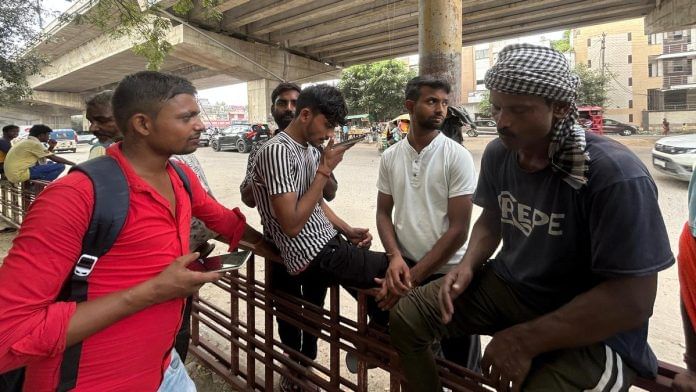New Delhi: Jagdish Prasad sweated fruitlessly at Noida Labour Chowk, waiting for a contractor to hire him for the day, anxiety climbing with the noonday sun. But that kind of daily struggle is long over for Santosh Kumar Shahni. At a Reliance gas plant construction site in Jind, he finished lunch after his morning shift. He now has a labour card, a provident fund account, and steady work lined up until the construction is done.
Two months ago, Shahni too was aimless and desperate in Muzaffarpur, Bihar. Then some friends told him about Digital Labour Chowk. It’s for construction workers what LinkedIn is for white-collar professionals and Gig4You is for delivery drivers. Santosh Kumar Shahni didn’t have a smartphone, so he called the number on the site and got himself registered. Within a month, he was hired.
It’s part of a growing wave of tech platforms that are trying to move manual labour hiring out of street corners and into the world of algorithms and apps. Urban Company did it for salon and domestic workers, Zomato and Swiggy for delivery persons, Ola and Uber for drivers. Now platforms like Digital Labour Chowk are doing it to formalise and streamline the construction segment.
It was started in 2020 by Chandrashekhar Mandal, a 29-year-old from Bihar, who decided to do something about the men he’d see crowding haplessly at Mayur Vihar Labour Chowk, which he’d pass on his way to work as an executive at a transport company. He wanted to give people an avenue to find jobs as carpenters, masons, electricians, and other forms of both skilled and unskilled work with more dignity and less toil.
“I wanted to create an equivalent of Naukri.com and LinkedIn for blue collar job seekers, and the DLC has proven to be one”, said Mandal. He claimed the platform currently has over 1.5 lakh workers registered and more than 10,000 companies hiring through it. The site says 80 per cent of businesses get their labour within 48 hours.

Blue-collar and high-tech are now intersecting in India. With McKinsey forecasting that 70 per cent of the 9 crore new jobs to be created in India by 2030 will be blue collar, filling market gaps has become an increasingly viable business. While some platforms such as WorkIndia and the AI-driven Vahan cater more broadly to blue- and grey-collar employment across sectors from manufacturing to logistics, Digital Labour Chowk is for now sticking to construction — a sector that currently employs about 7.1 crore workers in India.
For Digital Labour Chowk, growth was slow and funding scarce at first. In the past three years, it has added new features and ramped up promotions through influencers with a strong follower base in villages and small towns. There’s now a DLC Rojgar Android app and a Project Portal launched in June lets small-city contractors bid for large construction jobs. Mandal’s team is also developing a tool for employers to shortlist labourers by skill and location.
Speaking at the Construction Tech Demo Day by RealtyNXT earlier this year, he pointed out a critical industry pain point: “97 per cent of construction projects get delayed due to manpower issues.”
I wanted to give a platform for skilled and unskilled labour, creating an identity for them
-Chandrashekhar Mandal, founder, Digital Labour Chowk
Improving domestic opportunities could also help keep skilled workers at home. After the brain drain, a muscle drain may be next. Countries such as Russia, Armenia, and Israel are now recruiting Indian construction workers, along with traditional destinations in the Gulf. A 2022 report by the Construction Skill Development Council of India said India is the world’s largest source of migrant workers, and that ageing populations in countries like Japan and Germany have led them to invite more foreign labour.
“With this kind of platform, we have reached pan-India, and international opportunities are also opening. Today a person can reach anywhere. There will be a window of opportunity for labourers in India,” said Mandal.
However, Manish Sabharwal, vice chairman of TeamLease Services, an employment solutions company, is sceptical about how much digital platforms can really do for manual labour jobs. He said that information such as CVs for job-matching tends to be missing in this segment.
“Why isn’t Naukri.com or anybody else able to do it? Because it is very hard for them. There isn’t that much information,” he said. “It’s basically unskilled jobs, so it’s hard to have a résumé that can be matched. Even the big worker platforms are offering jobs, not doing matching. Unless we figure out ways to use identity and location services — maybe through digital public infrastructure — this won’t really work.”
Only 4.1 per cent of India’s workers have formal training, against about 26 per cent in China. Most manual workers in India learn on the job or from family through the old ustad-shagird apprenticeship system. Two decades of skill missions have barely nudged that figure by two percentage points.
Also Read: India is having a civil engineering crisis. Mumbai to Bihar, bridges to byways, highways to setu
Breaking the blue-collar digital divide
When cities ground to a halt during the March 2020 lockdown and migrant workers trudged home, Chandrashekhar Mandal also returned to Darbhanga. There, he finally had time to shape his idea of giving workers an alternative to jostling in chowks for daily work, often without luck.
“I wanted to give a platform for skilled and unskilled labour, creating an identity for them,” said Mandal.
He initially invested around Rs 40,000 of his own money.
“I thought this much would be enough to get the platform going,“ he said. But it took a while for the project to take off as grants and other sources of funding didn’t pan out.
The first big breakthrough came in 2022 when DLC won the National Innovation Challenge by Hitachi India and Kerala Startup Mission in the ‘reaching the unreached’ category. The prize was Rs 30 lakh as seed funding. In the following years, DLC got investments from Campus Fund, Spring Star Capital, and Nikken, among others. The platform also received government grants and funds under Startup Bihar, Startup India, and the CM Udyami Yojana in Bihar. In all, its funding has amounted to a total of about Rs 3 crore.
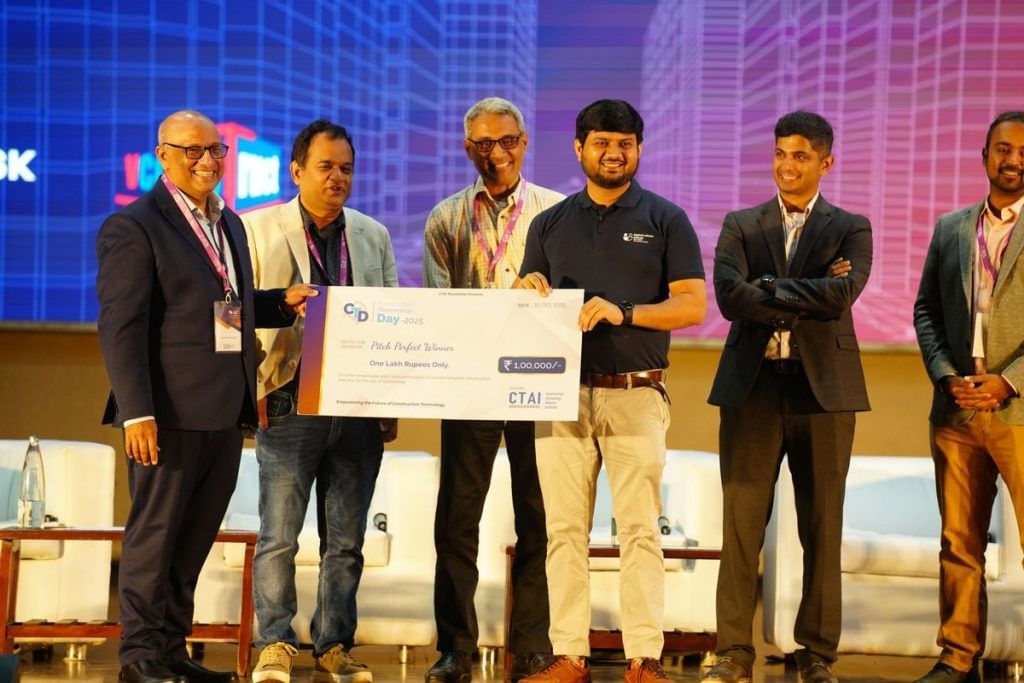
The company earns revenue from contractors, who pay Rs 5 for each worker profile viewed on the site, and through advertisements. The platform is free for workers. With offices in Noida and Bihar, it currently employs around 20 people, including a six-member tech team.
Around 35-40 per cent of its workforce is from Bihar, 25 per cent from Uttar Pradesh, and the rest from other states. The site also lists wage ranges based on state government guidelines.
Mandal says the goal is to use minimal manual effort to provide jobs. An AI-based system now helps job seekers find work by filtering location and kind of work.
People have continued to take labourers from chowk. It will take some time for digital platforms to take over
-Raju Prasad Gupta, founder of Labour Chowk
Other platforms are also tapping into this blue-collar hiring space. Delhi-based entrepreneur Raju Prasad Gupta launched Labour Chowk in 2018, originally as a website listing workers he met in Delhi-NCR. When online listings didn’t take off, he switched to a phone-based model. Customers started reaching out to him rapidly and more labourers were hired for jobs. The site still exists, listing nine-to-five daily wage rates such as Rs 900 for a mason, Rs 1,200 for heavy labour, and Rs 1,800 for a carpenter, with a 40-minute lunch break included.
Gupta said he currently works with about 10 companies and has a pool of 50 ‘permanent’ labourers.
“Every day we get calls from a few labourers looking for work,” he added.

Another rising blue- and grey-collar platform is Bengaluru-based Vahan.ai, founded by Madhav Krishna, who studied AI during his graduate studies in the US. The company, started in 2016, employs “AI-based chatbot technology” to connect companies with a network of recruitment agencies to hire blue-collar and gig workers. AI then automates the initial hiring process, screening, verifying documents, and conducting conversations.
“We spent a lot of time trying to make the voice sound very desi and not robotic,” Krishna said in an Indian Express interview, explaining that this model was more effective in a country where most people rely on relatives and word-of-mouth to get jobs.
ThePrint reached out to Krishna via multiple phone calls and texts but no response was received.

What all these platforms have in common is an effort to bring order to a largely unorganised sector. On Digital Labour Chowk, every registered worker now has a profile listing skills, experience, and qualifications — a basic résumé for those who’ve never had one. It’s also making hiring easier for companies.
Amit Singh, project manager at GPS Renewable Pvt Ltd, told ThePrint his firm recently hired 30 construction workers in Haryana through DLC.
“We used to traditionally ask people or inquire with contractors,” he said. “Now they are available virtually. It is easy to identify the skill set of the labourers, making the interaction easy and transparent.”
Kiosks in villages, influencers selling swag
Rohit Deshwal was looking for an on-site job near his home in Jind, Haryana. His mother was sick, and he needed to take care of her. He stumbled upon Digital Labour Chowk while looking for jobs on the internet. It was an easy road from there.
“I put the location as Jind, and fortunately, I found out about this job,” said Deshwal, who now works as a supervisor at the construction site of a bio plant in Jind.
Having completed a computer course at the Industrial Training Institute (ITI), Deshwal’s first job was in Palwal, where he earned a daily wage with no fixed salary.
“I deal with the company directly if I have any problem, and there is no contractor whom I have to go through. I receive my salary directly — there is no hassle,” he said. He currently earns Rs 18,000 a month for a nine-hour shift.
“I am happy I moved near my home. I can save some money, and I get to eat home-cooked food as well,” he added.
While the website is in English, a phone number is prominently displayed and it also relies on word of mouth.
I have no work today. I did not have anything yesterday. I send money to my family at the end of the month, I cannot afford to skip one day from work
-Jagdish Prasad, labourer
Even many who may not be fluent in English now have some level of digital literacy, and that is something DLC is trying to bank on. Mandal said the platform has also collaborated with social media influencers for marketing.
“We started sending out emails to YouTube and Instagram influencers and offered them an incentive to advertise DLC,” said Mandal. “We looked for people who have followers in millions.”
Several of the influencer posts use earthy humour and swagger to sell labour pride. Scenes of comeuppance, instant respect, and role reversal are common.

In one video, Aman Sharma, who has over 15 million Instagram followers, cruises in on a bike, pays for a friend’s groceries, and boasts he’ll “put an AC under every tree”. He tells his friend to download the DLC Rojgar app from Google Play to enjoy similar riches. “Uske baad tu paise jhaap,” he grins — after that, roll in money. The clip got 21 lakh likes and hundreds of comments.
Rahul Rajput, another influencer with 4 million followers on Instagram, gave it a romance angle: “Papa ki pariyon, apne Raja Babu ko bolo Digital Labour Chowk Rojgar App download karke paise kamana shuru kar de.” — Hey papa’s angels, tell your prince to download the app and start earning. His video got over 96,000 likes. Some joked that love matters more than money; others asked if the app really led to jobs, to which the official DLC handle replied with a link.
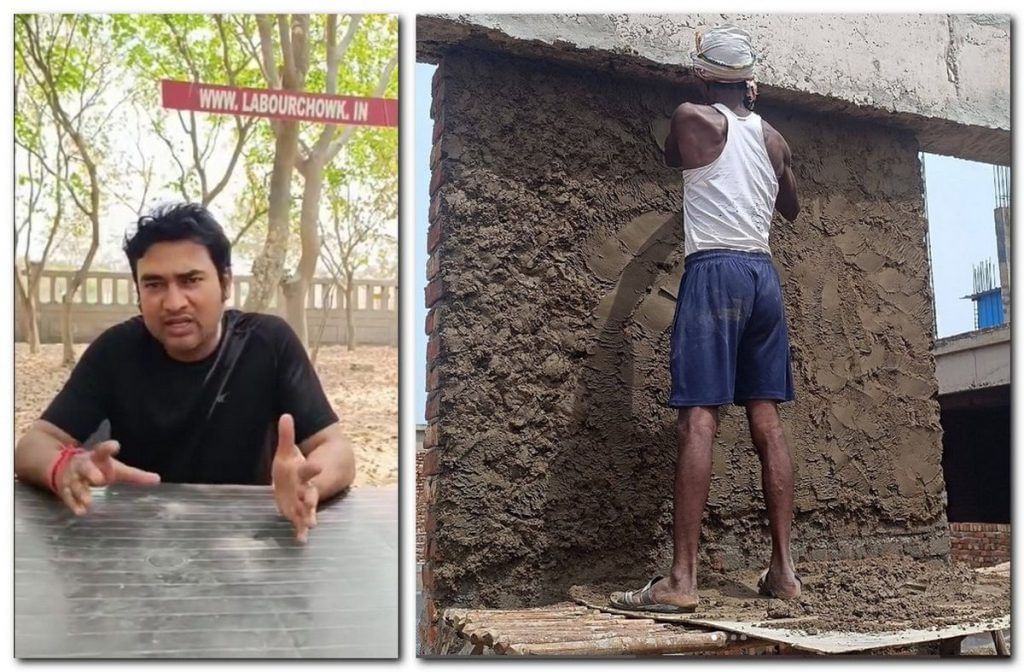
Some collaborations use social commentary. PK Waliya, with 4 lakh followers, shot a video from a labour chowk, framing DLC as a social-change model. It got 13,000 likes. Mangruz Filmz, with nearly 4 million followers, posted a skit showing a reporter mocking labourers for not studying — until they tell her they earn Rs 27,000 to her Rs 20,000. And Abhimanyu Bharadwaj, a smaller influencer with about one lakh followers, has made DLC videos in Maithili; one shared in August got over 30,000 likes.
Beyond social media, the company is trying to reach workers at the grassroots through kiosks in villages across Bihar. Mandal said these kiosks are run in partnership with local mobile stores, which receive incentives to help labourers register on the platform. They have also started online skill classes for labourers.
Despite the digital push, however, the old system continues to prevail.
“People have continued to take labourers from chowk. It will take some time for digital platforms to take over,” said Gupta.
Recruiters too sometimes prefer the traditional system for its immediacy.
“Hiring local labourers is cost-efficient for the company,” said Singh of GPS Renewable Pvt Ltd.
FLO Mobility Pvt Ltd—which makes autonomous robots for material movement— also hires through Digital Labour Chowk, but a company executive, Pratyush Raj, said the process can be slow.
“We need more labourers in a shorter span of time,” he added.
Also Read: Small hotels are the backbone of India’s new sex culture. And this is their daily fight
Labour rush hour
In the last three years, the digital sector for blue-collar workers has grown by about 10 per cent, according to Gupta. But awareness is still low.
Madhav Singh, a contractor who has been operating in Delhi and the NCR for over two decades, said he had never heard of such digital platforms. Most workers ThePrint met at chowks were also unaware that a website or app could connect them to employers directly.
At Green Valley Peace Chowk in Noida, there’s a morning rush. Cars and bikes pull over to hire labour and contractors scan the crowd of men. If they are not chosen for the day, they will not be earning any money and may even go hungry. A car stops and the crowd runs toward it, hoping to get hired.
The labour chowk concept has existed for centuries, ever since men started migrating from villages for cities and began gathering at street corners for work. As industries grew through the 19th and 20th centuries, those corners turned into daily hiring hubs, a system that still runs the same way today.
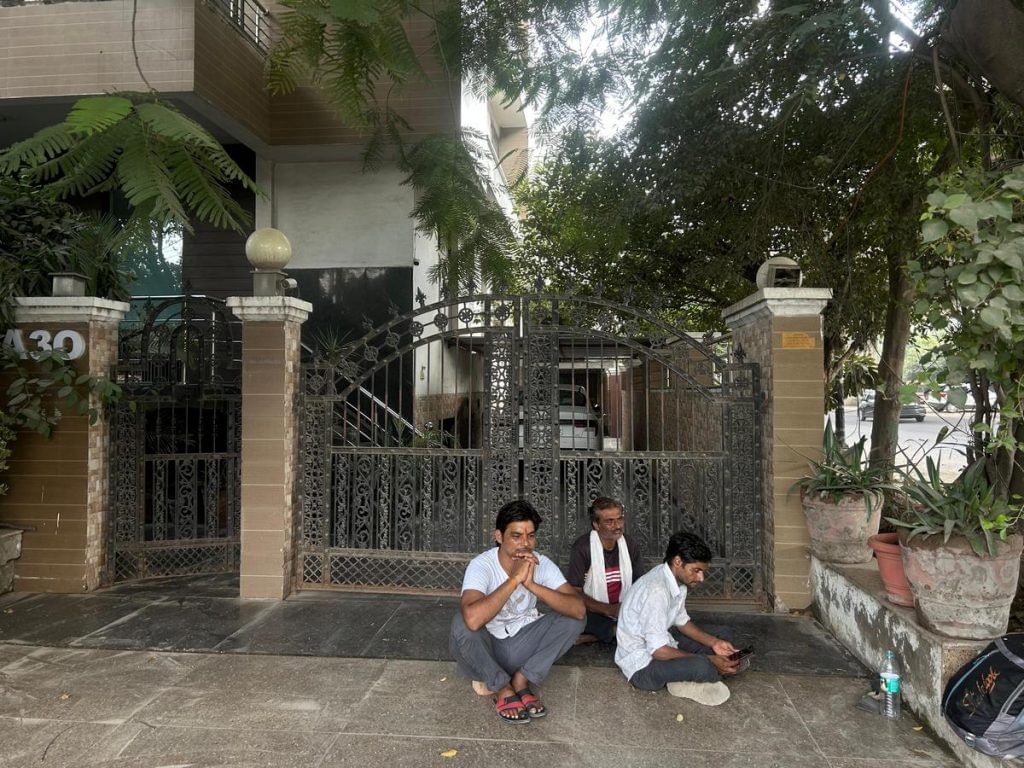
The chaos at the Noida chowk continues from 8 am until about noon. The crowd thins after that, but some such as Jagdish Prasad are still waiting.
“I have no work today. I did not have anything yesterday. I send money to my family at the end of the month, I cannot afford to skip one day from work,” said Prasad.
As the clock strikes one, the men give up. Some settle down to play a game of cards, while others like Prasad sit quietly in a rest area created for the labourers by the Uttar Pradesh government. Some do not get jobs because of their age, and others because they do not qualify for the work. It’s not uncommon for the men to drink alcohol in these areas, leading to unruly behaviour.
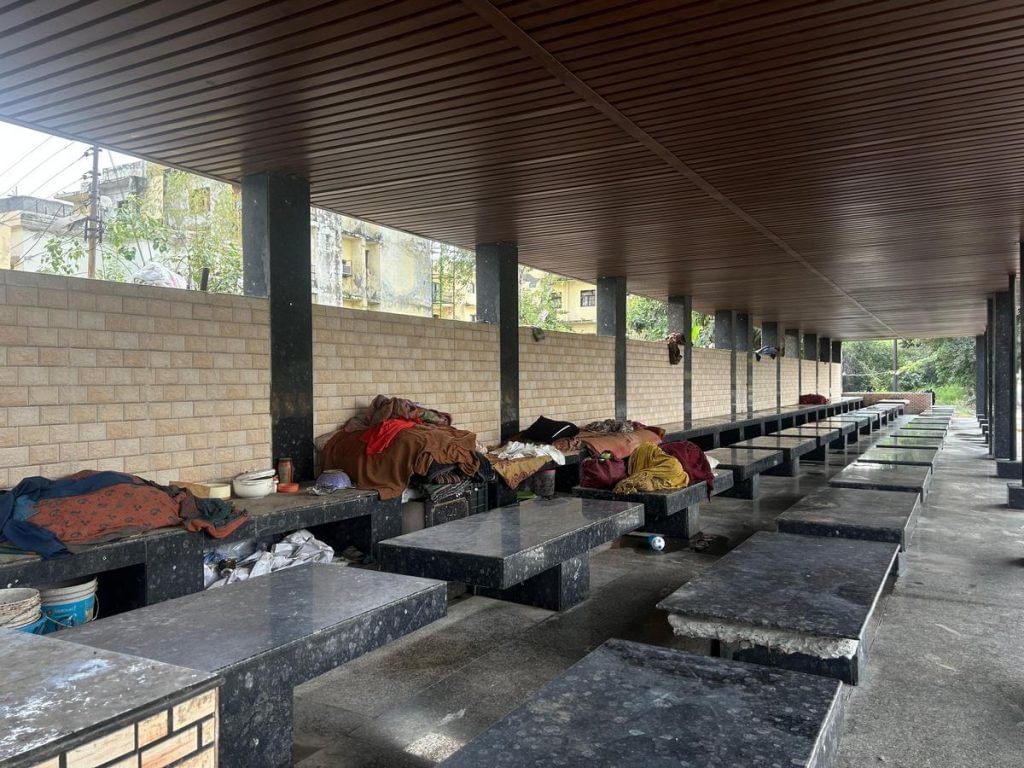
“We cannot sit there with other labourers — most of them are drunk, and they fight among each other after losing money in card games,” said Singh. “Two days ago, a labourer died here, and nobody could find any reason.”
Santosh Kumar Shahni worried constantly after he left his job as a fitter at the blue-chip company L&T. The salary never came on time.
Back home in Bihar, a labour supplier from his village, Raju Babu, helped him register on Digital Labour Chowk. He soon found work in Jind, where he has worked for over four months.
But he gets paid on time. And there is dignity.
“I am happy that I found this job, even if it is far from my home,” he said. “For people like us it is important that we get paid on time.”
(Edited by Asavari Singh)



